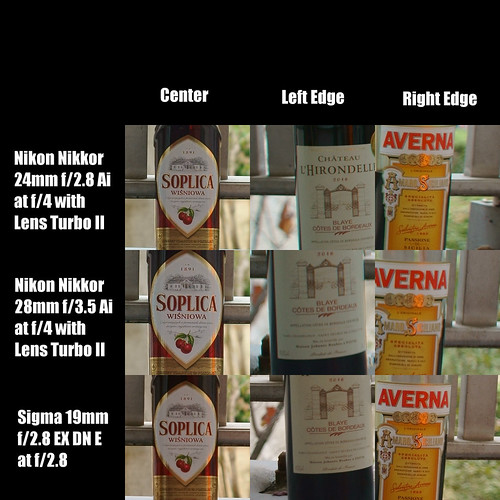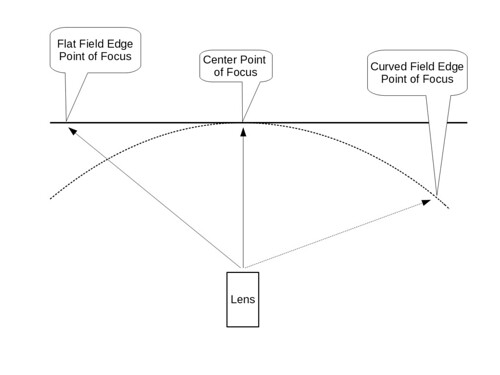[UPDATE 29 January 2022 - I was definitely out of my depth here with this post. I have since learned that the field curvature I observed is not the fault of the Nikon Nikkor 24mm f/2.8 Ai lens. The curvature is introduced with the use of the Lens Turbo II focal reducer. It does not change the fields of all lenses to this degree. The Nikon lens in question is beautiful and I'm glad I kept it. You can read my mea culpa in a post I made four years after this one.]
I've wanted to like the Nikon 24mm f/2.8 manual focus lens. Really, I have. But every time I compare it against the cheap, small, light, modern Sigma 19mm f/2.8 EX DN E, it loses out. The corners are soft every single time I try to conduct a comparison. I had a f/2 version of the 24mm Nikkor that behaved just as poorly.
Having owned these lenses for years I sold the f/2 version out of frustration. The entire experience has been nearly maddening. I couldn't imagine how Nikon could've screwed up two versions of the same focal length.
Early one morning I was cogitating on the edges of a dream-like state and something occurred to me. I suddenly felt I should check for field curvature. Figure 1 illustrates the effect I'm talking about.
What I thought about was how Nikon might have designed these lenses to have a plane of focus that was equidistant from the lens (IOW, a curved field). So I quickly set up a test. The scene is simple. To place the two bottles near the edge of the frame, I scribed an arc from the lens where all three bottles sat on that arc.
Then I compared three lenses.

Indeed, the 24mm f/2.8 Ai Nikkor appears to be designed with a point of focus that is equidistant from the lens across the field. This, to me, means it is deliberately not a "flat field" lens.
With this lens, however, the portion of the image that is in focus does not "pull" or exhibit sagittal distortions. The subject is rendered "naturally". And this may be the very reason why the lens was designed this way in the first place.
Considered in this new understanding, the Nikon Nikkor 24mm f/2.8 is actually a very fine optic. I just have to keep in mind it's characteristics when using it.
As for the 28mm f/3.5 lens, the edge performance at f/4 is not sufficiently good for me to draw any conclusions about it's design nor field curvature. I could've stopped the lens down further, but the depth of field might have been too great for me to detect it's point of focus at the edges of the frame.
The control lens, however, is quite outstanding and, though the effect is subtle, the railing is more in focus than the bottles. This re-confirms for me that it's design is more "flat field" than the Nikkor 24mm. Not "better" than the Nikkor 24mm, just "different" and more in line with what I expected (before conducting this little test).
Having owned these lenses for years I sold the f/2 version out of frustration. The entire experience has been nearly maddening. I couldn't imagine how Nikon could've screwed up two versions of the same focal length.
Early one morning I was cogitating on the edges of a dream-like state and something occurred to me. I suddenly felt I should check for field curvature. Figure 1 illustrates the effect I'm talking about.
What I thought about was how Nikon might have designed these lenses to have a plane of focus that was equidistant from the lens (IOW, a curved field). So I quickly set up a test. The scene is simple. To place the two bottles near the edge of the frame, I scribed an arc from the lens where all three bottles sat on that arc.
Then I compared three lenses.
- Nikon Nikkor 24mm f/2.8 Ai at f/4
- Nikon Nikkor 28mm f/3.5 Ai at f/4
- Sigma 19mm f/2.8 EX DN E at f/2.8
Here is the scene setup. As you can see, the bottles near the edge of the frame are well forward of the railing. The railing represents the straight line. The three bottles were placed on an arc equidistant from the lens, where the center bottle is resting against the railing/straight line.
Here are the results (click on the image and select the full resolution image to look at the details).

Figure 1


No comments:
Post a Comment